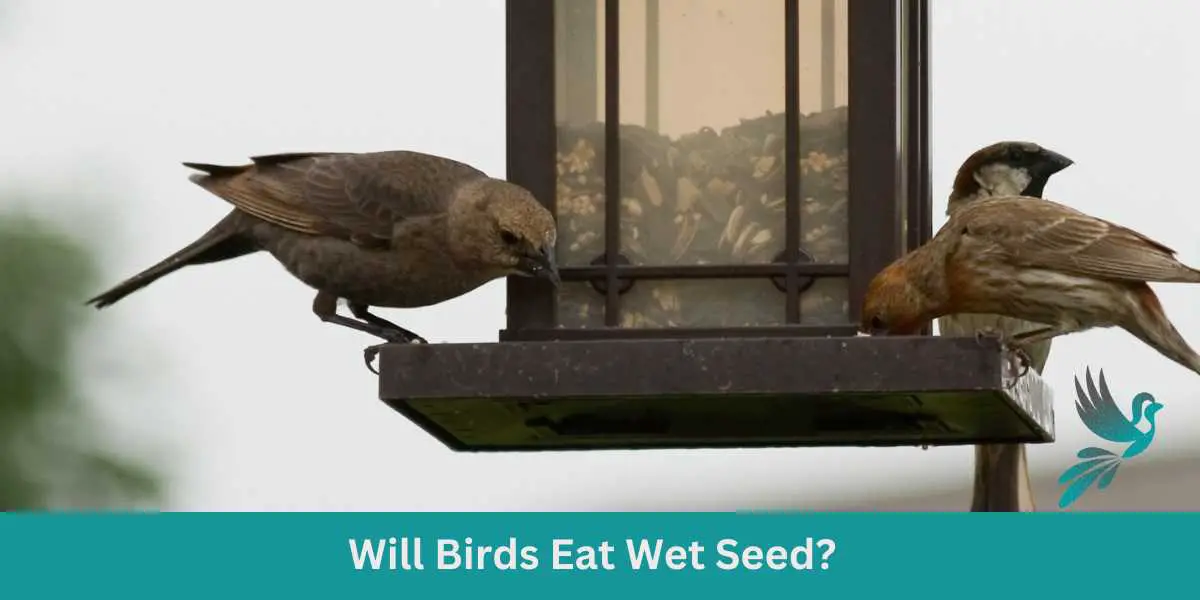Perhaps you’ve accidentally left your birdseed out in the rain, or you’re considering soaking it before putting it out to attract a wider variety of birds. Either way, you’re in the right place to find the answer!
Most birds will eat freshly wet seeds. However, they will stop eating them because they prefer fresh, dry seeds most of the time.
In this blog post, we’ll answer other common questions related to bird feeding. We’ll cover different ways to keep your bird seed dry, the importance of feeding birds dry seeds and more.
Key Takeaways on Wet Bird Seed
- Birdseeds usually prefer fresh, dry seeds.
- Wet bird seeds can be a breeding ground for bacteria and fungi, attract pests, and become moldy quickly.
- Keeping bird seed dry with feeders with waterproof lids/roofs, covered areas, tarp/umbrellas, or containers is essential.
Why wet bird seeds are bad for birds?
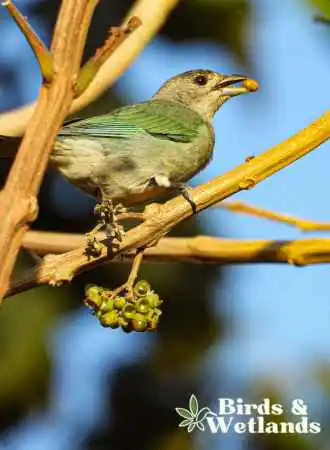
There are several reasons why wet birdseeds are bad for birds. Let’s start with the very obvious one.
Wet birdseeds can be a breeding ground for bacteria and fungi. When birdseeds are soaked, they create a warm and moist environment, promoting the growth of harmful microorganisms. If birds eat contaminated seeds, they may get sick with an avian disease or bacterial infection.
Wet birdseed can attract unwanted pests, insects and rodents, spreading disease in your garden. These animals and other wildlife can make a mess in your yard or garden, creating an unhygienic environment for birds and humans. Monitor seed waste and combat seed stealing squirrels by removing discarded seed and using squirrel baffle.
When seeds are exposed to moisture, they spoil quickly and become moldy, making them unappetizing to birds. Additionally, oily seeds such as black oil sunflower seeds clump. If birds don’t eat the seeds, they can attract more pests and cause an even bigger mess. Remove discarded seed before you end up with sprouted seeds on the ground.
How to keep bird seed dry?
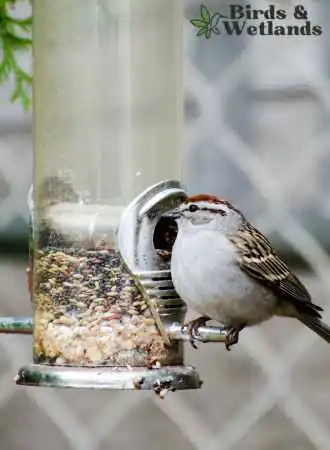
Keeping bird seeds dry is essential. After all, no one wants to attract rats or other pests that can spread diseases. But don’t worry, there are plenty of ways to avoid wet bird seed to keep your backyard friends healthy.
First, consider investing in a good-quality bird feeder with a waterproof lid or drain holes. These seed feeders are designed to keep typical spring rain and snow out of the seed supply, ensuring they stay dry and edible for backyard birds. When choosing a seed bird feeder, look for sturdy, durable materials that can withstand different weather conditions.
Another option is to place your bird feeder under a covered area such as a tree, awning or roof. This will provide some shelter from the rain and help to keep the seeds dry. However, ensure that the area you choose is safe and easily accessible for the many species of birds.
If you don’t have a covered area to place your bird feeder, you can create your own shelter by attaching an umbrella or tarp to the feeder. This will act as a makeshift roof, keeping the seeds dry and preventing them from getting wet. Just make sure to secure the umbrella or tarp properly to prevent it from blowing away in the wind.
Another tip is storing bird seed in a waterproof seed storage container or bin. This is particularly useful if you buy bird seed in bulk or store it for long periods. Store excess seed smartly and keep them dry at all times.
Air tight containers will keep the seeds dry and prevent too much moisture from getting in. You can also consider adding a moisture absorber, such as silica gel packs or charcoal, to the container to help absorb enough moisture. Additionally, the perfect storage location for your seed is out of reach of animals.
Lastly, if you’re short on options and can’t keep your birdseeds dry, it’s best to remove the wet birdseeds and replace them with fresh, dry ones. Wet seeds can quickly become moldy and unhealthy for the birds, so it’s important to keep an eye on your feeder and regularly clean it to prevent mold or bacteria buildup.
If you noticed sprouting seeds or rodent droppings, remove them from your feeders or containers.
How to dry out wet bird seed?
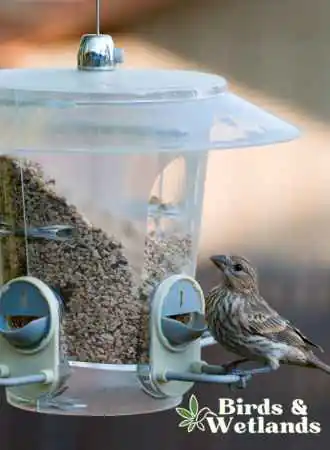
If your seeds got wet after a rain or snow melt, don’t worry. You can actually salvage newly wet birdseeds and prevent them from spoiling.
Here’s how you dry wet birdseeds due to summer downpour, sudden thaw in winter, late season tropical storm, bad weather or heavy rain:
- The first step to drying out wet bird seed is to remove it from its container. If the seed is in a feeder, take it down and dump the wet seed out. If the seed is in a bag, open it up and pour the wet seed onto a clean, flat surface.
- Clean your feeders with mild soap and water solution to remove oily stains and dry completely before use.
- Spread the wet bird seed out in a thin layer on a clean, dry surface. This will help to increase the surface area and allow the seed to dry more quickly. You can scatter them onto a newspaper which helps absorb moisture.
- Allow the wet bird seed to dry in a warm, dry location. This could be in a sunny spot in your yard or inside your home near a heater or dehumidifier. Stir the seed occasionally to help it dry evenly.
- After a few hours, check the seed for moisture. If it still feels damp, stir it again and let it dry for a few more hours. Repeat this process until the seed is completely dry.
- Don’t store the dried seeds; put them back in your feeders. Let the birds consume them first before refilling your feeders with a fresh batch of seeds.
Will birds eat moldy seeds?
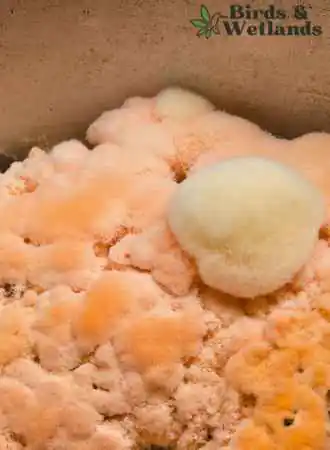
It depends on the bird species and the type of mold. Some birds may eat moldy seeds without issue, while others may avoid them. However, moldy seeds can be harmful to visiting birds and household pets as some molds produce toxins that can lead to illness or death.
It is best to avoid feeding wild birds spoiled seed mixes and instead provide them with fresh, high-quality birdseed. Remove discarded seeds from your feeding station before you end up with an absolute mess.
What are the best bird feeders for rainy weather?
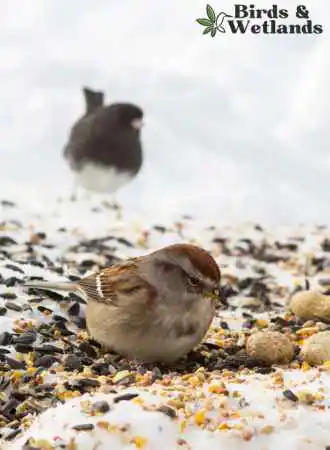
When it comes to selecting bird feeders that are suitable for rainy weather, there are a few things to keep in mind. Here are some options that are designed to keep birdseed dry and prevent mold and mildew growth:
- Covered Feeders: These are bird feeders that have a roof or a cover that shields the feeding ports from rain. There are many types of covered feeders available, such as hopper feeders, gazebo feeders, and tube feeders with a rain guard. The cover helps keep the seed dry and fresh, preventing it from getting wet and clumping together.
- Squirrel-Proof Feeders with a Hood: Squirrel-proof feeders often have a hood that covers the feeding ports, which can also help protect the seed from rain. Some of these feeders have adjustable hoods that you can tilt to block rain, while still allowing birds to access the seed.
- Drip Trays: If you have a bird feeder that doesn’t have a cover, you can use a drip tray to catch any rainwater that gets in. This will prevent the seed from getting wet and provide a dry area for birds to perch and eat. Some feeders come with drip trays, while others may require you to purchase one separately. Other feeders have drainage holes in their seed trays.
The best bird feeder for rainy weather will depend on your specific needs and the types of birds you want to attract. It’s important to choose a feeder that is easy to clean and maintain, and that will keep the seed dry and fresh for the birds to enjoy.

